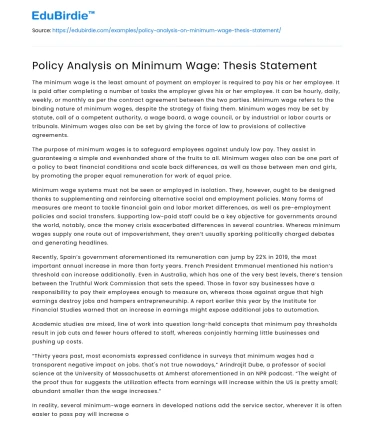Introduction
The debate surrounding minimum wage policies is a perennial topic in economic and social discourse. As governments worldwide grapple with the challenge of ensuring a fair standard of living for their citizens, the implementation of minimum wage laws has become a focal point of policy analysis. This essay seeks to critically evaluate the effects of minimum wage policies, examining their implications on employment, economic growth, and income equality. A comprehensive understanding of these policies is crucial as they serve as a foundational element in the broader discourse on social welfare and economic stability. By analyzing empirical data and theoretical perspectives, this essay posits that while minimum wage policies can elevate living standards for low-income workers, they also pose potential risks to employment levels and economic growth if not carefully calibrated. This analysis will delve into various dimensions of the minimum wage debate, providing a balanced examination of the potential benefits and drawbacks associated with these policies.
Economic Implications of Minimum Wage Policies
The economic ramifications of minimum wage policies are multifaceted and often disputed among economists. Proponents argue that increasing the minimum wage can boost consumer spending, reduce poverty, and improve the quality of life for low-income workers. According to a study by the Economic Policy Institute, raising the minimum wage in the United States could lift approximately 1.3 million workers out of poverty. By providing workers with higher disposable income, minimum wage increases can stimulate economic activity, as evidenced by historical data showing positive GDP growth following wage hikes in various regions.
Save your time!
We can take care of your essay
- Proper editing and formatting
- Free revision, title page, and bibliography
- Flexible prices and money-back guarantee
However, opponents contend that these policies may lead to unintended economic consequences, such as increased unemployment and inflation. A report from the National Bureau of Economic Research suggests that while modest minimum wage increases have limited negative effects, substantial hikes could lead to job losses, particularly among small businesses that cannot absorb the higher labor costs. This argument is supported by the case of Seattle, where a significant minimum wage increase led to a reduction in low-wage employment hours, as businesses adjusted to the higher wage bill. Therefore, the economic impact of minimum wage policies is contingent upon the balance between the benefits of increased worker income and the potential drawbacks of reduced employment opportunities.
Social Outcomes of Minimum Wage Adjustments
Beyond the economic sphere, minimum wage policies also have profound implications for social equity and quality of life. Advocates assert that a higher minimum wage can contribute to reducing income inequality by narrowing the income gap between low-wage and high-wage earners. This is particularly relevant in countries with significant wage disparities, where minimum wage laws act as a tool for social justice and economic redistribution. For example, the introduction of a living wage in the United Kingdom was associated with a reduction in income inequality and an improvement in the standard of living for the lowest-paid workers.
Conversely, critics argue that minimum wage hikes may not effectively target the most vulnerable populations, such as the unemployed or those in informal sectors who do not benefit from wage increases. A study published in the Journal of Economic Perspectives highlights that while minimum wage policies can improve the earnings of those already employed, they may not address broader issues of unemployment and underemployment. Moreover, there is a risk that employers may respond to wage increases by reducing non-wage benefits or increasing automation, potentially disadvantaging low-skilled workers. Thus, while minimum wage policies aim to enhance social welfare, their effectiveness in achieving equitable outcomes remains a topic of contention.
Balancing Policy Objectives and Economic Realities
The challenge of designing effective minimum wage policies lies in balancing the intended social and economic objectives with the realities of market dynamics. Policymakers must consider the diverse impacts of wage adjustments on different sectors and demographic groups, ensuring that policies are adaptable to varying economic contexts. For instance, a nuanced approach that allows for regional variations in minimum wage levels may better accommodate the differing cost of living and economic conditions across regions.
Furthermore, integrating complementary policies, such as tax credits and workforce development programs, can mitigate some of the negative effects of minimum wage increases. By enhancing the skills and productivity of low-wage workers, these measures can help sustain employment levels and support economic growth. As noted by Nobel Laureate economist Joseph Stiglitz, "A multifaceted approach that combines wage policies with supportive social programs can create a more inclusive and resilient economy." Hence, a holistic policy framework that addresses both wage levels and broader socioeconomic factors is essential for achieving sustainable and equitable economic outcomes.
Conclusion
In conclusion, minimum wage policies represent a complex intersection of economic theory and social justice. While they hold the potential to uplift low-income workers and promote economic equity, their implementation requires careful consideration of potential economic trade-offs. The evidence suggests that moderate increases in minimum wage levels can stimulate economic activity and reduce poverty, but significant hikes may pose risks to employment and business sustainability. Policymakers must adopt a balanced approach that incorporates regional variations and complementary measures to maximize the positive impacts of minimum wage policies. Ultimately, the success of these policies hinges on their ability to adapt to dynamic economic conditions while remaining steadfast in their commitment to enhancing the welfare of the most vulnerable members of society.






 Stuck on your essay?
Stuck on your essay?

